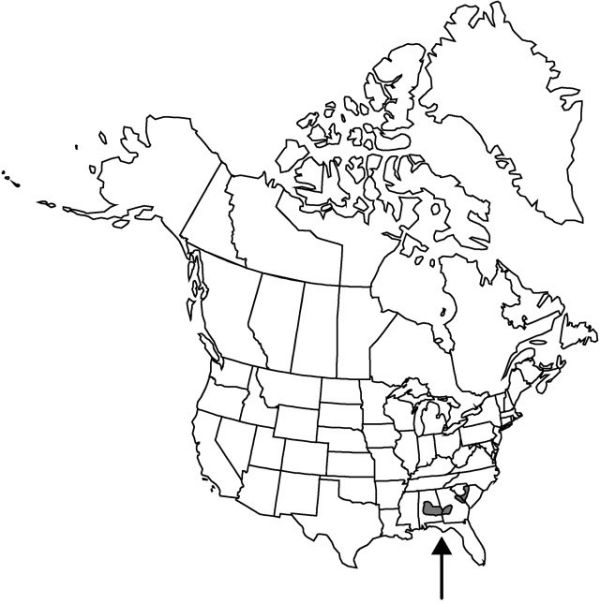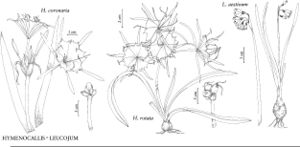Hymenocallis coronaria
Enum. Pl. 5: 855. 1850.
Bulb nonrhizomatous, globose, 4–8 × 3.5–7.5 cm; basal plate 1–2 cm; neck 2.5–3.5 cm; tunic brown. Leaves deciduous, 3–6, erect, (3.8–)5–9.5 dm × 1.5–4.5 cm, coriaceous; blade prominently channeled proximally, becoming expanded and reflexed in distal 1/3, liguliform, apex acute. Scape 4–12.5 dm, 2-edged, glaucous; scape bracts 2, enclosing buds, 4–6.5 × 1.5–2 cm; subtending floral bracts 3.5–4 × ca. 1 cm. Flowers 3–7(–12), opening sequentially, fragrant; perianth tube green, 4.5–7.5(–9) cm; tepals ascending, white, tinged green at base, 6.5–10 cm × 5.5–9 mm; corona white with prominent yellowish green eye, broadly funnelform to chalicelike, tubulose proximally, 4.5–7 × 5–8.5 cm, margins between free portions of filaments often with 2 prominent dentations; free portions of filaments inserted on flat sinal base, incurved, white, 1–2 cm; anthers 1–1.7 cm, pollen golden; ovary ovoid, 1–1.8 cm × 5–10 mm, ovules 2–4 per locule; style green in distal 1/3, fading into white, 11–18 cm. Capsules subglobose, 3 × 3 cm. Seeds elongate, 2.5–4.3 × 1.2–2.1 cm. 2n = 44.
Phenology: Flowering late spring–early summer.
Habitat: Rocky shoals of Piedmont river systems above and at the Fall Line
Elevation: 100–200 m
Distribution

Ala., Ga., S.C.
Discussion
Hymenocallis coronaria is under consideration for federal protection. It may be locally abundant in some places, but at other sites where it was once abundant, whole populations have been wiped out by dams (J. K. Small 1933; L. J. Davenport 1990b, 1996). The environments where populations still exist should be protected to ensure their continued existence.
Hymenocallis coronaria is one of the most magnificent plants in nature. In 1783 William Bartram was the first botanist to observe this species, as the “odoriferous Pancratium fluitans which almost alone possesses the little rocky islets” (W. Bartram 1791). His sighting was at the cataracts of the Savannah River, Augusta, Georgia. Distinguishing features are channeled leaves that may reach over a meter in length, and staminal coronas that are among the largest of the genus, being chalicelike at full anthesis. These characteristics make it highly desirable for cultivation in streams and brooks of our southern gardens.
There has been some confusion in the literature as to the identity of Hymenocallis coronaria (A. E. Radford et al. 1968). However, L. J. Davenport (1990) and G. L. Smith et al. (1990) have confirmed its distinctive characteristics and unique habitat. An interesting discovery by Davenport that H. coronaria seeds sink offers a mechanism for its local dispersion and establishment in favorable environments. Support for its inclusion with H. occidentalis in Traub’s Caroliniana Alliance has been provided by the production of viable F1 hybrids in a greenhouse cross between H. occidentalis (seed parent, 2n = 54) and H. coronaria (pollen parent, 2n = 44). As expected, the hybrids have 2n = 49 (D. B. Joye and G. L. Smith 1993), and after several years are still thriving in the High Point University greenhouse.
Selected References
None.
